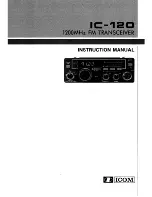
Options
Reference Guide: TT128x High Definition Professional Receiver/Decoder
Page 6-5
ST.RE.E10141.5
6.4
DVB-S2 Input Cards (TT1280/HWO/DVBS2
and TT1280/HWO/DVBS2/IF/CONST)
6.4.1 General
The DVB-S2 Input card supports DVB-S, QPSK demodulation and DVB-S2,
QPSK and 8PSK demodulation.
Two options are available. TT1280/HWO/DVB-S2 offers four L-band inputs,
TT1280/HWO/DVB-S2/IF/CONST offers three L-band inputs plus an
IF monitor input plus received constellation output.
6.4.2
Connector Details - L-Band Inputs
Connect the L-band output of a suitable LNB to the
F-type connector either directly or via a suitable
attenuator giving adequate consideration to lightning
and surge protection. The active input is chosen using
the Input Status Menu (Menu 2).
In most cases an attenuator will not be required. The following list
summarises the circumstances when one should be used.
When the desired input level is greater than the specified maximum
permissible (-25 dBm).
When the downlead is a short length of low-loss cable and the LNB in use
has a poor return loss (7 dB min).
When the Receiver is receiving one of many carriers in a multi-carrier FDM
system and the level of the wanted signal is close to the specified
maximum permissible.
The specification for this connector is given in Annex B, Technical
Specification.
Table 6.3: DVB-S2 Satellite Receiver (L-band) Connector
Input Specification
Connector Type
F-type, Female
Connector designation
IN 1, IN 2, IN 3, IN 4
Pin: Centre
Shield
RF Input
Ground/Chassis
LNB Supply
Refer to the next caution box
Impedance 75
Ω
6.4.3
Connector Details – IF Monitor Input
(TT1280/HWO/DVBS2/IF/CONST)
Connect the IF Monitor input to a suitable IF frequency source
e.g. a satellite modulator. The input can be activated using
Input Status Menu (Menu 2).
This monitor input is designed to give error free demodulation
in the presence of a wanted carrier only, for example when
being fed directly from a satellite modulator.
IN 1/2/3/4
















































